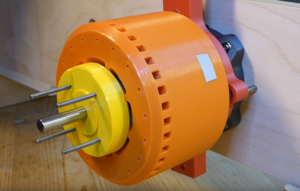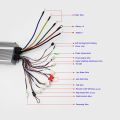Motors: Difference between revisions
No edit summary |
No edit summary |
||
| (14 intermediate revisions by the same user not shown) | |||
| Line 1: | Line 1: | ||
{{Parts infobox | {{Parts infobox | ||
|image = Motor.png | |image = Motor.png | ||
| | |designers = | ||
|date = | |date = | ||
|vitamins = | |vitamins = | ||
|materials = | |materials = [[Steels]] | ||
|transformations = | |transformations = | ||
|lifecycles = | |lifecycles = | ||
|parts = [[Bolts]], [[Nuts]], [[Washers]] | |parts = [[Bolts]], [[Nuts]], [[Washers]], [[Magnets]], [[Wires]] | ||
|techniques = | |techniques = | ||
|tools = [[3D printers]] | |tools = [[3D printers]] | ||
| | |files = | ||
|suppliers = | |||
|git = | |git = | ||
}} | }} | ||
| Line 18: | Line 19: | ||
=Introduction= | =Introduction= | ||
<youtube>XH2bykD70jI</youtube> | |||
An electric motor is an electrical machine that converts electrical energy into mechanical energy. Most electric motors operate through the interaction between the motor's magnetic field and electric current in a wire winding to generate force in the form of torque applied on the motor's shaft. Electric motors can be powered by direct current (DC) sources, such as from batteries, or rectifiers, or by alternating current (AC) sources, such as a power grid, inverters or electrical generators. An electric generator is mechanically identical to an electric motor, but operates with a reversed flow of power, converting mechanical energy into electrical energy. | An electric motor is an electrical machine that converts electrical energy into mechanical energy. Most electric motors operate through the interaction between the motor's magnetic field and electric current in a wire winding to generate force in the form of torque applied on the motor's shaft. Electric motors can be powered by direct current (DC) sources, such as from batteries, or rectifiers, or by alternating current (AC) sources, such as a power grid, inverters or electrical generators. An electric generator is mechanically identical to an electric motor, but operates with a reversed flow of power, converting mechanical energy into electrical energy. | ||
=Challenges= | =Challenges= | ||
Electric motors are expensive and difficult to manufacture, and not universally available. Most [https://en.wikipedia.org/wiki/Thermoplastic thermoplastics] operate at low [https://en.wikipedia.org/wiki/Melting_point melting points] not suitable for intense or prolonged motor operation. | Electric motors are expensive and difficult to manufacture, and not universally available. Most [https://en.wikipedia.org/wiki/Thermoplastic thermoplastics] operate at low [https://en.wikipedia.org/wiki/Melting_point melting points] not suitable for intense or prolonged motor operation. | ||
<youtube>57M_c6M1c0o</youtube> | |||
=Approaches= | =Approaches= | ||
==Standards== | |||
* NEMA 17/23/34 | |||
* 550/555/775/795/895/997 DC Motor | |||
* face mount / pedestal mount | |||
3D print an electric motor using [[recycled plastics]] selected specially for high durability and heat resistance, [[3D printers]], and [[vitamins]]. Design with [https://en.wikipedia.org/wiki/Investment_casting investment casting], and direct metal printing in mind. | 3D print an electric motor using [[recycled plastics]] selected specially for high durability and heat resistance, [[3D printers]], and [[vitamins]]. Design with [https://en.wikipedia.org/wiki/Investment_casting investment casting], and direct metal printing in mind. | ||
<gallery> | <gallery> | ||
| Line 45: | Line 55: | ||
* [https://www.thingiverse.com/thing:4785716 Brushless Motor] | * [https://www.thingiverse.com/thing:4785716 Brushless Motor] | ||
== | ==Servo motors== | ||
<youtube>RhnFUuMgao8</youtube> | |||
==Cyclodial== | |||
<youtube>RkGU2v9tBFE</youtube> | <youtube>RkGU2v9tBFE</youtube> | ||
<youtube>Emvo3bLT-Z4</youtube> | <youtube>Emvo3bLT-Z4</youtube> | ||
| Line 54: | Line 66: | ||
==Sterling motors== | ==Sterling motors== | ||
* [https://seftonmotors.com/ Sefton motors] | * [https://seftonmotors.com/ Sefton motors] | ||
==PCB motors== | |||
<youtube>oa6sP-joAr8</youtube> | |||
<youtube>OzqSzFZa2DY</youtube> | |||
==Alternatives== | ==Alternatives== | ||
| Line 71: | Line 87: | ||
* [http://www.laimer.ch/ Christoph Laimer] | * [http://www.laimer.ch/ Christoph Laimer] | ||
* [https://en.wikipedia.org/wiki/Electric_motor Wikipedia: Electric motor] | * [https://en.wikipedia.org/wiki/Electric_motor Wikipedia: Electric motor] | ||
* [https://web.archive.org/web/20080516024656/http://www.scary-terry.com/wipmtr/wipmtr.htm Using a wiper motor in your Halloween projects by Scary Terry] | |||
* [http://www.motorsformakers.com/ Motors for Makers] | |||
Latest revision as of 19:13, 27 January 2023
Introduction
An electric motor is an electrical machine that converts electrical energy into mechanical energy. Most electric motors operate through the interaction between the motor's magnetic field and electric current in a wire winding to generate force in the form of torque applied on the motor's shaft. Electric motors can be powered by direct current (DC) sources, such as from batteries, or rectifiers, or by alternating current (AC) sources, such as a power grid, inverters or electrical generators. An electric generator is mechanically identical to an electric motor, but operates with a reversed flow of power, converting mechanical energy into electrical energy.
Challenges
Electric motors are expensive and difficult to manufacture, and not universally available. Most thermoplastics operate at low melting points not suitable for intense or prolonged motor operation.
Approaches
Standards
- NEMA 17/23/34
- 550/555/775/795/895/997 DC Motor
- face mount / pedestal mount
3D print an electric motor using recycled plastics selected specially for high durability and heat resistance, 3D printers, and vitamins. Design with investment casting, and direct metal printing in mind.
Stepper Motors
Brushless DC motors
Servo motors
Cyclodial
- Dual Cycloidal 41:1 Internal BLDC
- AMT102-V inexpensive shaft mounted rotary encoder with adapters for various motor and shaft types
- Mechaduino servo controller
Sterling motors
PCB motors
Alternatives
- 1/2 Horsepower 115 Volt AC 1725 RPM Magnetek Motor
- Salvaged AC, DC, or universal motor - permanent magnet or inductive
Tools
Development targets
- https://www.thingiverse.com/thing:20177
- https://www.thingiverse.com/thing:11164
- IRFP260N mosfets - 50A 200V - $3 ea Ebay - same as Controller

